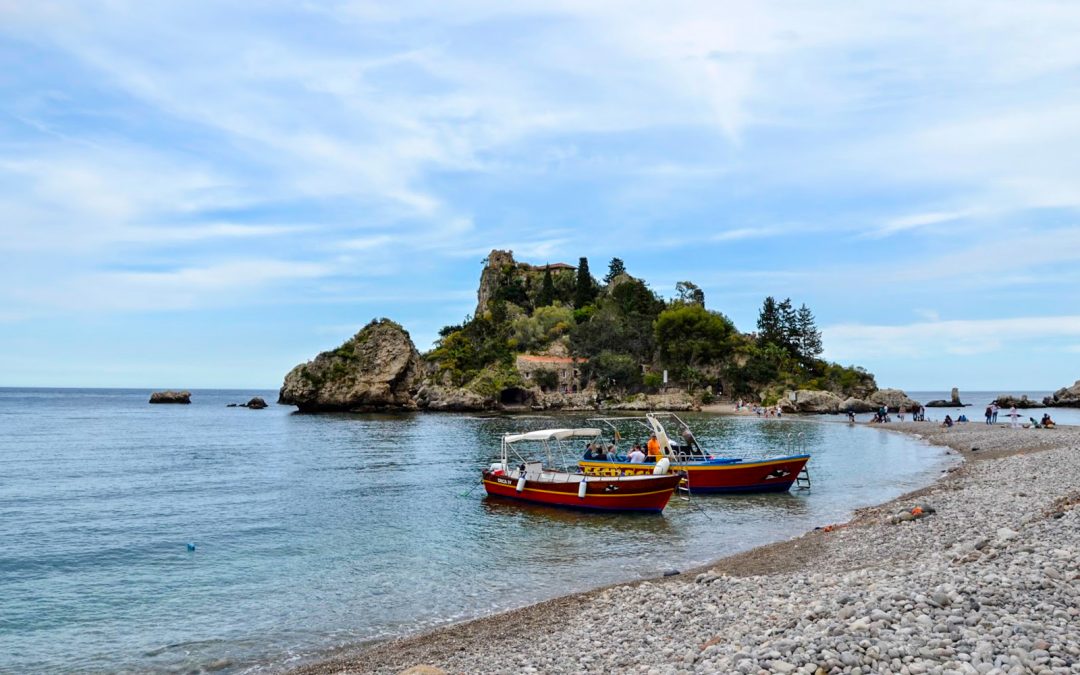.
.
Day 3:
On the third day we took a bus to Taormina, on the other side of the island, about 3h30 from Palermo. Taormina is a city on the top of the mountain, but very close to the coast, with a cable car that connects the city to the beach, the Funivia Taormina-Mazzaró. It is also possible to see the Etna volcano from the city – when it is not cloudy, which wasn’t the case when I was there… In Taormina we did couchsurfing and our host lived in an amazing condominium on the seafront, so the first thing we did was to go for a swim on “our private beach”. Then it got cloudy so we went for a walk. We started with a visit to Isola Bella, an island connected to the land by a sandbar that is today a Nature Reserve, almost like a botanical garden.
We then took the cable car to the city and after crossing Porta Messina, we headed to the famous Via Comunale Gardens, with a beautiful view of the city. The city of Taormina is characterized by narrow streets, where it is a pleasure to get lost, many stairs and beautiful squares. The largest is Piazza IX Aprile, the city’s balcony to the sea. A little further on we find Piazza Duomo, with its cathedral, much smaller than we imagined. We then arrive at Porta Catania, which marks the limits of the historic city.
We returned home and that night our host, who already worked as a chef, cooked us Pasta alla Norma, a typical Sicilian dish based on eggplant, salted ricotta and tomato, a delight.
.
.
.
Day 4:
The next morning we visited the Greek Theater or Teatro Antico di Taormina, with a privileged location overlooking the sea and possibly Etna, if there were no clouds … From there you can also see the Taormina Castle and the Madonna della Rocca Church, on another hill, which we didn’t have the opportunity to visit, due to lack of time.
From Taormina we continue to Catania, about an hour’s drive from Taormina. Catania is the second-largest city on the island, destroyed by an earthquake in 1693 and then rebuilt, making its historic center more recent. With Etna as a neighbor, it was obvious to rebuild the city with volcanic stone. Still, there are some exceptions that resisted the earthquake, such as the Roman Theater, the first thing we visited, on the way to Piazza del Duomo, where we can find the Elephant Fountain, a symbol of the city, the cathedral and the Porta Uzeda, all made of volcanic stone. We continued on Via Etnea, passed Piazza Università and arrived at Piazza Stesicoro where the remains of an ancient Roman amphitheater, below street level, are possible to visit. With our hostess, also a couchsurfer, we walked along Via dei Crociferi towards Castle Ursino, but we arrived after closing, so we could only see outside, something that did not amaze me. As good guests, we invited our hostess and her boyfriend to dinner at a Trattoria in the city and I had to order Pasta alla Norma again – but I never ate one as good as the first! This was the only day we spent in Catania, which was again not enough – the ideal would be another day or two in Sicily than we planned.
.
.
.
Day 5:
On the fifth day, I said goodbye to Maria and continued alone to Agrigento, a trip of about 2 hours by bus, to visit the Valley of the Temples. On the way I finally got to see Etna without clouds and, surprise, it was full of snow! After arriving in the city, there are several buses that go to the valley, halfway between the city and the sea. This archaeological site is quite different from any I have ever visited. Instead of a city, we found several temples scattered around, with little connection between them. It is still impressive, of the twelve great temples there is one almost complete and another close to whole! I had still thought about visiting the city but in the meantime, it started raining a lot and as the bus to Palermo was every two hours, I decided to catch the one at 16:30. The bus takes two hours to cross the island from south to north. In Palermo, a friend of Sofia, couchsurfer, was waiting for me, since she was no longer in the city.
.
.
.
.
.
.
.
Summary:
Day 1, Palermo: Vucciria market, Porta Felice, the gulf of Palermo, the port of la Cala, Loggiato di San Bartolomeo and San Domenico church. Quattro Canti, Teatro Massimo, Teatro Politeama, Piazza Pretoria, San Cataldo, Chiesa della Martorana, Porta Nuova, the cathedral. Ballarò Market, Casa Professa.
Day 2, Palermo: Mondello beach, Monreale, Taberna Azzurra
Day 3, Taormina: take a dip on the beach, Isola Bella, Porta Messina, the Giardini della Via Comunale, Piazza IX Aprile, Piazza Duomo, Porta Catania.
Day 4, Taormina and Catania: the Greek Theater or Teatro Antico di Taormina, [the Castello di Taormina and the Madonna della Rocca Church.] The Roman Theater of Catania, Piazza del Duomo, the Elephant Fountain, the cathedral and the Porta Uzeda. Via Etnea, Piazza Stesicoro with the Roman amphitheater, Via dei Crociferi and Castello Ursino.
Day 5, Agrigento: The Valley of the Temples.
Day 6, Palermo: church of San Giovanni degli Eremiti, Royal Palace, Palatine Chapel, Antica Focacceria San Francesco, Church of Santa Maria dello Spasimo, Orto Botanico, walls of the city
Day 7, Palermo: catacombs, top of the cathedral, church of the Quattro Canti, Palazzo Abatellis
*Must see in bold
If you liked this post and want to read more about my trips to Italy, you can visit the following posts:
















